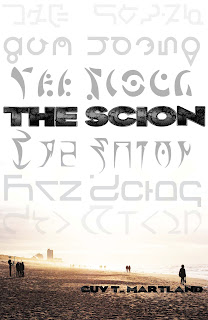 |
| 'Oryx & Crake' and 'The Drought' missing in action... |
When compiling this list I thought about the books which have left enduring impressions on me, whether these be images, atmospheres, ideas or characters. My imagination tends to be cinematic – as I read the images roll over the screen of my mind, and the more striking the better. In my novel ‘The Scion’, I tried my best to write what I was seeing, which gave the book a visual feel. My hope was that some of the images I’ve created would have the same kind of long-lasting effect as the books I most admire.
This is a book I return to again and again. It was the first McAuley I read and one
of the books that kickstarted my interest in SF. The descriptions of a terraformed Mars jolted my imagination
awake, the settings lingering in my mind.
I had the pleasure of meeting the author at Worldcon last year, when he
told me (as he signed my first edition hardback) this was one of his
favourites. I just smiled, being a
bit starstruck.
Where would we be without the late, great Iain M? This book has it all – some wonderful
set pieces, epic landscapes and a seriously cool female lead to boot. An antiquity hunter, Sharrow is a
strong and believable character.
The Lazy Guns are without comparison and possibly one of the coolest
inventions in SF. Added to which
there are monowheels (a kind of supercharged motorbike), cable cars,
glass-bottomed swimming pools, hovercraft… Dark, as the title suggests, humorous and a book which grows
on second, third and fourth reads.
The author of this novel may not consider this to be SF, but
I do. Science has effectively
destroyed Earth, after the release of Crake’s monster virus (SF, right?). The grim post-apocalyptic tone of this
book takes hold from the outset and doesn’t let go. But there is a lesson here for humanity – about what could
happen if science’s advances are allowed to progress unchecked. This is Frankenstein for our
times. It could really happen one
day.
A brilliant Banksian rollercoaster ride on the ridiculously
named planet of Spatterjay, where a plethora of bizarre creatures grow with
abandon. The drones in this are
seriously sophisticated, kick-ass machines. And the transformed Hoopers, infected by the Spatterjay
virus, are a nice touch. Asher’s
finest moment.
5. The Dramaturges of Yan – John Brunner
5. The Dramaturges of Yan – John Brunner
An alien world filled with ancient artefacts, a galaxy known
artist who creates on a celestial scale, the strange effects of the Shrimashey
drug: Brunner manages to summon a world which is fascinating and truly
strange. There is even a kind of
internet (written before this existed).
At the same time, there is something very Seventies about this book,
which doesn’t seem to date it, but instead gives it a retro feel.
More artefacts, this time a mysterious eponymous space hub
created by a vanished race called the Heechee. Travelling on the alien craft located in the hub to
different worlds is a kind of Russian roulette, with the accompanying financial
rewards making this a space race on a different scale. The analysis sessions through which the
protagonist reveals the secrets of Gateway lend a humanising context. I read this for the first time in one
sitting, spellbound, each new world visited as thrilling as the last.
No best SF list would be complete without some Ballard. This was one of a series of apocalyptic
novels, although they are otherwise unrelated. His writing is clinical, detached and paradoxically
completely submerges the reader in a world without water. Reading this is like being transported
into a surrealist landscape, where nothing quite makes sense. There is a mirage-like touch to the
prose that sticks, like your tongue to the back of your dry mouth.
This book opened my mind to the unbelievable depth of
space. That hundreds of civilisations
could have lived and died before humans even emerged from the cat’s cradle of
evolution on Earth. Of course, in
Rama itself, there is an alien artefact which requires exploration (you
detecting a theme here?). And,
yes, space really is that big.
9. The Day of the Triffids – John Wyndham
9. The Day of the Triffids – John Wyndham
I was brought up with the Triffids. They were there on the television
creaking around through 80s TV sets and devouring people. For a while I thought they were real. Later I consumed the book like the voracious
Triffid reader I am. The idea of
the meteor show blinding Earth’s inhabitants, rendering them powerless to the
Triffids’ advances is haunting and I still have a mild panic attack any time I
hear of (or even witness) a meteor shower.
10. Stone – Adam Roberts
10. Stone – Adam Roberts
Roberts turns his hand to many different tropes in SF, his
books diverse and fascinating.
Here he does space opera on a grand scale, whizzing through many
different exotic planets with an assured prose. And for his third outing, this feels like a book from a much
more experienced writer. High
concepts abound: faster than light travel, quantum physics and intelligent
nanotechnology (dotTech) which has created a kind of human utopia (or has it?). On reading this, I almost shouted with
joy, revelling in the fact that modern SF has so much to offer. Simply breathtaking.
This blog post originally appeared on Margo Bond Collins' blog on the 7th July 2015, as part of the blog tour for my novel 'The Scion'.

